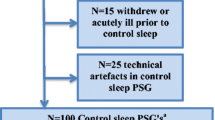Summary
Nine adult asthmatics with a history of nocturnal symptoms and with morning dips in peak expiratory flow (PEF) were treated for 10–14 days with 24-h controlled-release preparation of theophylline (Th), or a controlled-release preparation of terbutaline (Te), in a double-blind cross-over experiment.
During treatment with 450–900 mg Th in the evening morning, plasma drug levels ranged from 53–95 (mean 73) μmol/l. The Te dose was 7.5 mg twice daily. Morning PEF values during Th (mean 338 l·min−1) and Te (316 l·min−1) were not significantly different. There were no significant differences between the treatments in average nocturnal oximetric O2 saturation (91.9% during Th and 91.0% during Te), or the amount of nocturnal body movement, recorded with a static charge sensitive bed (total number of movements 146 during Th and 120 during Te).
No difference between the treatments was seen with respect to assessment by the subjects of sleep quality, which was considered fair or good.
The findings suggest that in moderately severe asthma, nocturnal oxygenation and sleep quality were similar during the two treatments.
Similar content being viewed by others
References
Turner-Warwick M (1977) On observing patterns of airflow obstruction in chronic asthma. Br J Dis Chest 71: 73–86
Fairfax AJ, McNabb WR, Davies HJ, Spiro SG (1980) Slow-release oral salbutamol and aminophylline in nocturnal asthma: relation of overnight changes in lung function and plasma drug levels. Thorax 35: 526–530
Barnes PJ, Greening AP, Neville L, Timmers J, Poole GW (1982) Single-dose slow-release aminophylline at night prevents nocturnal asthma. Lancet I: 299–301
Fan Chung K, Barnes PJ (1988) New drugs: Respiratory and allergic disease. I. Br Med J 296: 29–33
Catterall JR, Douglas NJ, Calverley PMA, Brash HM, Brezinova V, Shapiro CM, Flenley DC (1982) Irregular breathing and hypoxaemia during sleep in chronic stable asthma. Lancet I: 301–304
Montplaisir J, Walsh J, Malo JL (1982) Nocturnal asthma: features of attacs, sleep and breathing patterns. Am Rev Respir Dis 125: 18–22
Rhind GB, Connaughton JJ, McFie J, Douglas NJ, Flenley DC (1985) Sustained release choline theophyllinate in nocturnal asthma. Br Med J 291: 1605–1607
Stewart IC, Rhind GB, Power JT, Flenley DC, Douglas NJ (1987) Effect of sustained release terbutaline on symptoms and sleep quality in patients with nocturnal asthma. Thorax 42: 797–800
Mordelet-Dambrine M, Baglin J-Y, Roux A, Dusser D, Flouvat B, Huchon G (1986) Comparison between theophylline analysis by nephelometric inhibition immunoassay and high performance liquid chromatography. Ther Drug Mon 8: 106–110
Alihanka J (1982) Sleep movements and associated autonomic nervous activities in young male adults. Acta Physiol Scand [Suppl 511]: 1–85
Salmi T, Leinonen L (1986) Automatic analysis of sleep records with static charge sensitive bed. EEG Clin Neurophysiol 64: 84–87
Salmi T, Telakivi T, Partinen M (1989) Evaluation of automatic analysis of SCSB, airflow and oxygen saturation signals in patients with sleep related apneas. Chest 96: 255–261
Gregg I, Nunn AJ (1973) Peak expiratory flow in normal subjects. Br Med J 3: 282–284
Koeter GH, Postma DS, Keyzer JJ, Meurs H (1985) Effect of oral slow-release terbutaline on early morning dyspnoea. Eur J Clin Pharmacol 28: 159–162
Eriksson L, Jonson B, Eklundh G, Persson G (1988) Nocturnal asthma: effects of slow-release terbutaline on spirometry and arterial blood-gases. Eur Respir J 1: 302–305
Neuenkirchen H, Wilkens JH, Oellerich M, Sybrecht GW (1985) Nocturnal asthma: effect of a once per evening dose of sustained release theophylline. Eur J Respir Dis 66: 196–204
Grossman J (1988) Multicenter comparison of once-daily Uniphyl tablets administered in the morning or evening with baseline twice-daily theophylline therapy in patients with nocturnal asthma. Am J Med 85: 11–13
Svedmyr N (1988) Xanthines. In: Barnes PJ, Rodger IW, Thomson NC (ed) Asthma: basic mechanisms and clinical management. Academic Press, Cambridge, pp 607–627
Karttunen P, Tukiainen H, Nykänen S, Saano V (1985) Night-time pharmacokinetics of once a day theophylline: a steady state comparison of three preparations. Int J Clin Pharmacol Ther Toxicol 23: 161–165
Bengtsson U, Sandberg N, Bake B, Löwhagen O, Svedmyr N, M»nsson J, Carlsson S (1985) Gastro-oesophageal reflux and night-time asthma. Lancet I: 1501–1502
Ekström T, Tibbling L (1988) Influence of theophylline on gastro-oesophageal reflux and asthma. Eur J Clin Pharmacol 35: 353–355
Davies DS (1984) Pharmacokinetics of terbutaline after oral administration. Eur J Respir Dis 65 [Suppl 134]: 111–117
Billing B, Dahlqvist R, Garle M, Hörnblad Y, Ripe E (1982) Separate and combined use of terbutaline and theophylline in asthmatics. Eur J Respir Dis 63: 399–409
Martin RJ, Cicutto LC, Ballard RD, Goldenheim PD, Cherniak RM (1989) Circadian variations in theophylline concentrations and the treatment of nocturnal asthma. Am Rev Respir Dis 139: 475–478
Zwillich CW, Neagley SR, Cicutto L, White DP, Martin RJ (1989) Nocturnal asthma therapy. Inhaled bitolterol versus sustained-release theophylline. Am Rev Respir Dis 139: 470–474
Author information
Authors and Affiliations
Rights and permissions
About this article
Cite this article
Brander, P.E., Sovijärvi, A.R.A., Salmi, T. et al. Nocturnal oxygen saturation and body movement in asthmatics treated with controlled-release preparations of theophylline or terbutaline. Eur J Clin Pharmacol 39, 117–121 (1990). https://doi.org/10.1007/BF00280043
Received:
Accepted:
Issue Date:
DOI: https://doi.org/10.1007/BF00280043




